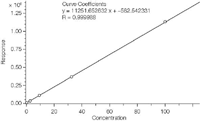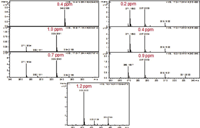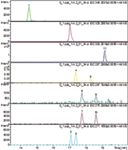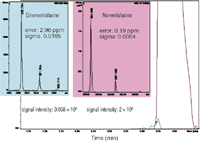Accurate, High Sensitivity Analysis of Impurities
LCGC Asia Pacific
Bruker Daltonics Application Note
Modern analytical applications often demand definitive tandem MS results on ever more complex samples using fast separation techniques. maXis is the only mass spectrometer able to deliver the maximum MS performance specification at the very highest speeds delivered by modern ultra performance liquid chromatography (UPLC) and capillary electrophoresis (CE). The maXis is specially designed to deliver excellent results in many applications including:
• Small molecule identification.
• Impurity and degradent identification.
• In vitro and in vivo drug metabolite identification.
• Intact protein analysis.
• Quantitative proteomics and protein identification.

Figure 1: Dilution series of okadaic acid from 0.1 to 100 ppb.
Redefining High Performance Mass Spectrometry
With resolution in excess of 40,000 and MS and MS–MS mass accuracy typically between 600–800 ppb at speeds of up to 20 full spectra per second simultaneously, no other mass spectrometer is better equipped to deliver definitive data on complex samples in proteomics, metabolomics and small molecule identification challenges.

Figure 2: Mass Accuracy determination for a variety of steroid molecules at 100 ppb.
Typical Results from the maXis
• 20 Hz speed of acquisition at high resolution for high-speed chromatography.
• 40 k+ resolution in both MS and MS–MS mode.
• Wide dynamic range of 5 orders of magnitude for trace detection in complex mixtures.
• Sub-ppm mass accuracy in both MS and MS–MS mode for high confidence i.d.s.

Figure 3: Extracted Ion Chromatograms of 0.1 ppb of various steroids.
Sensitivity and Dynamic Range Determination
In this study, the maXis was challenged to measure low level impurities. The maXis was easily able to detect compounds at 0.1 ppb and exhibited at least a four order of magnitude dynamic range for quantification. In addition, when challenged with even co-eluting compounds of several orders of magnitude difference in concentration, the maXis was readily able to identify and measure both compounds despite the difference in concentration. The maXis would seem to meet many criteria for use as an instrument to measure and detect low level impurities in terms of sensitivity, dynamic range and mass accuracy.

Figure 4: Analysis of a co-eluting impurity. In this example Dinorvenlafaxine and Norvenlafaxine co-elute with a difference of 250 Ã in concentration, but the maXis detects and identifies both despite the difference in concentration.
Bruker Daltonics Inc.

Billerica, Massachusetts 01824, USA
tel. +1 978 663 3660 fax +1 978 667 5993
E-mail: ms-sales@bdal.com
Website: www.bdal.com

AOAC International Awarded NIST Grant for Developing Drug Testing Standards
October 31st 2024The grant will be part of a new collaborative scientific initiative to address the need for standards that define the desired performance of lateral flow immunoassay test strips to detect illicit drugs in tablets and powders.
AI and GenAI Applications to Help Optimize Purification and Yield of Antibodies From Plasma
October 31st 2024Deriving antibodies from plasma products involves several steps, typically starting from the collection of plasma and ending with the purification of the desired antibodies. These are: plasma collection; plasma pooling; fractionation; antibody purification; concentration and formulation; quality control; and packaging and storage. This process results in a purified antibody product that can be used for therapeutic purposes, diagnostic tests, or research. Each step is critical to ensure the safety, efficacy, and quality of the final product. Applications of AI/GenAI in many of these steps can significantly help in the optimization of purification and yield of the desired antibodies. Some specific use-cases are: selecting and optimizing plasma units for optimized plasma pooling; GenAI solution for enterprise search on internal knowledge portal; analysing and optimizing production batch profitability, inventory, yields; monitoring production batch key performance indicators for outlier identification; monitoring production equipment to predict maintenance events; and reducing quality control laboratory testing turnaround time.